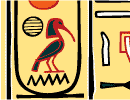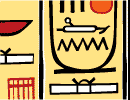The New York Times -- April 6, 1999
Who Began Writing? Many Theories, Few
Answers
By JOHN NOBLE WILFORD
 HILADELPHIA
-- The Sumerians had a story to explain their invention of writing more than
5,000 years ago. It seems a messenger of the king of Uruk arrived at the
court of a distant ruler so exhausted from the journey that he was unable to
deliver the oral message. So the king, being clever, came up with a
solution. He patted some clay and set down the words of his next messages on
a tablet.
HILADELPHIA
-- The Sumerians had a story to explain their invention of writing more than
5,000 years ago. It seems a messenger of the king of Uruk arrived at the
court of a distant ruler so exhausted from the journey that he was unable to
deliver the oral message. So the king, being clever, came up with a
solution. He patted some clay and set down the words of his next messages on
a tablet.
A Sumerian epic celebrates the achievement:
Before that time writing on clay had not yet existed,
But now, as
the sun rose, so it was!
The king of Kullaba [Uruk] had set words on a
tablet, so it was!
A charming just-so, or so-it-was, story, its retelling at a recent
symposium on the origins or writing, held here at the University of
Pennsylvania, both amused and frustrated scholars. It reminded them that
they could expect little help -- only a myth -- from the Sumerians
themselves, presumably the first writing people, in understanding how and
why the invention responsible for the great divide in human culture between
prehistory and history had come about.
|
Early Writing: Cultures Make Their First
Marks
|
|
Representing spoken
language in writing grew out of the transformation of pictures and
random marks into images with consistent meaning. Among the earliest
cultures to do this were:
|
|
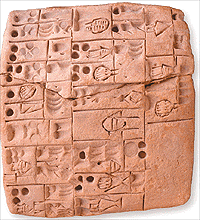 |
|
SUMERIA, 3,200 B.C. This
Mesopotamian culture is generally thought to be the first culture to
produce written texts. In the example above the Sumerians used a
stylus and wet clay to record the ingredients for
beer. |
|
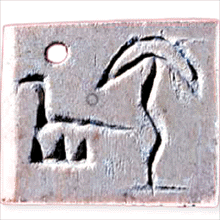 |
|
EGYPT, 3,200 - 3,000 B.C. Early Egyptians used a system of pictorial hiero-glyphics as a
written language. The earliest examples (above) were phonetically
arranged symbols on small clay tablets used to indicate payments for
commodities. It reads “Mountain of Light.” |
|
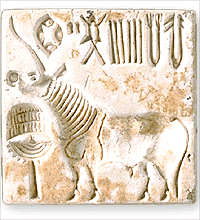 |
|
INDUS VALLEY, 2,500 B.C. Ceramic
seals like the one shown above were used by the inhabitants of what is
now Pakistan to indicate ownership or destinations for bundles of
goods. The scripts in the upper right corner are individual
characters. |
|
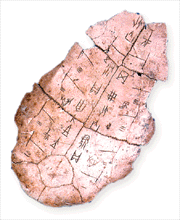 |
|
CHINA, 1,500 - 1,200 B.C. During
the Shang Dynasty the Chinese began to inscribe divinations on the
underside of turtle shells and ox bones. These artifacts are now
referred to as oracle bone inscriptions. |
|
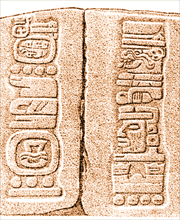 |
|
MESOAMERICA 250 - 300 B.C. The
Olmecs, Mayans and Zapotecs are thought to be the first of many
cultures in this region to develop writing. Shown above is an early
Zapotec example that is still untranslated.
Sources: “Old
World Civilizations,” by the American Museum of Natural
History
Jim McManus/The
New York Times; Photographs courtesy of Margaret Nissen, German
Archeological Institute and Harappa Archeological Research
Project
|
The archeologists, historians and other scholars at the meeting smiled at
the absurdity of a king's writing a letter that its recipient could not
read. They also doubted that the earliest writing was a direct rendering of
speech. Writing more than likely began as a separate and distinct symbolic
system of communication, like painting, sculpture and oral storytelling, and
only later merged with spoken language.
Yet in the story, the Sumerians, who lived in Mesopotamia, the lower
valley of the Tigris and Euphrates Rivers in what is now southern Iraq,
seemed to understand writing's transforming function. As Dr. Holly Pittman,
director of the university's Center for Ancient Studies and organizer
of the symposium, observed, writing "arose out of the need to store
information and transmit information outside of human memory and over time
and over space."
In exchanging interpretations and new information, the scholars
acknowledged that they still had no fully satisfying answers to the most
important questions of exactly how and why writing was developed. Many of
them favored a broad explanation of writing's origins in the visual arts,
pictograms of things being transformed into increasingly abstract symbols
for things, names and eventually words in speech. Their views clashed with a
widely held theory among archeologists that writing grew out of the pieces
of clay in assorted sizes and shapes that Sumerian accountants had used as
tokens to keep track of livestock and stores of grain.
The scholars at the meeting also conceded that they had no definitive
answer to the question of whether writing was invented only once and spread
elsewhere or arose independently several times in several places, like
Egypt, the Indus Valley, China and among the Olmecs and Maya of
Mexico and Central America. But they criticized recent findings suggesting
that writing might have developed earlier in Egypt than in
Mesopotamia.
In December, Dr. Günter Dreyer, director of the German Archeological
Institute in Egypt, announced new radiocarbon dates for tombs at
Abydos, on the Nile about 250 miles south of Cairo. The dates indicated that
some hieroglyphic inscriptions on pots, bone and ivory in the tombs were
made at least as early as 3200 B.C., possibly 3400. It was now an "open
question," Dr. Dreyer said, whether writing appeared first in Egypt
or Mesopotamia.
At the symposium, Dr. John Baines, an Oxford University Egyptologist who
had just visited Dr. Dreyer, expressed skepticism in polite terms. "I'm
suspicious of the dates," he said in an interview. "I think he's being very
bold in his readings of these things."
The preponderance of archeological evidence has shown that the urbanizing
Sumerians were the first to develop writing, in 3200 or 3300 B.C. These are
the dates for many clay tablets with a proto-cuneiform script found at the
site of the ancient city of Uruk. The tablets bore pictorial symbols
for the names of people, places and things for governing and commerce. The
Sumerian script gradually evolved from the pictorial to the abstract, but it
was probably at least five centuries before the writing came to represent
recorded spoken language.
Egyptian hieroglyphics are so different from Sumerian cuneiform, Dr.
Baines said, that they were probably invented independently not long after
Sumerian writing. If anything, the Egyptians may have gotten the idea of
writing from the Sumerians, with whom they had contacts in Syria, but
nothing more.
In any event, the writing idea became more widespread at the beginning of
the third millennium B.C. The Elamites of southern Iran developed a
proto-writing system then, perhaps influenced by the proto-cuneiform of
their Sumerian neighbors, and before the millennium was out, writing
appeared in the Indus River Valley of what is now Pakistan and western
India, then in Syria and Crete and parts of Turkey. Writing in China dates
back to the Shang period toward the end of the second millennium B.C., and
it dates to the first millennium B.C. in Mesoamerica.
Archeologists have thought that the undeciphered Indus script, which
seemed to appear first around 2500, may have been inspired in part from
trade contacts with Mesopotamia. But new excavations in the ruins of the
ancient city of Harappa suggest an earlier and presumably independent
origin of Indus writing.
In a report from the field, distributed on the Internet, Dr. Jonathan
Mark Kenoyer of the University of Wisconsin and Dr. Richard H. Meadow of
Harvard University showed pictures of marks incised on potshards that they
interpreted as evidence for the use of writing signs by Indus people as
early as 3300 B.C. If these are indeed proto-writing examples, the discovery
indicates an independent origin of Indus writing contemporary with the
Sumerian and Egyptian inventions.
Dr. Meadow, using E-mail, the electronic age's version of the king of
Uruk's clay tablet, confirmed that the inscribed marks were "similar in some
respects to those later used in the Indus script." The current excavations,
he added, were uncovering "very significant findings at Harappa with respect
to the Indus script."
At the symposium, though, Dr. Gregory L. Possehl, a Pennsylvania
archeologist who specializes in the Indus civilization and had examined the
pictures, cautioned against jumping to such conclusions. One had to be
careful, he said, not to confuse potter's marks, graffiti and fingernail
marks with symbols of nascent writing.
Of the earliest writing systems, scholars said, only the Sumerian,
Chinese and Mesoamerican ones seemed clearly to be independent inventions.
Reviewing the relationship between early Chinese bronze art, "oracle bones"
and writing, Dr. Louisa Huber, a researcher at Harvard's Fairbanks Center
for East Asian Research, concluded, "Chinese writing looks to be pristine."
But few pronouncements about early writing go undisputed. Dr. Victor
Mair, a professor of Chinese language at Penn, offered evidence indicating,
he said, that "the Chinese writing system may well have received vital
inputs from West Asian and European systems of writing and proto-writing."
Dr. Mair cited an intriguing correspondence between the Chinese script
and 22 Phoenician letters and also Western-like symbols on pottery and the
bodies of mummies found in the western desert of China. The recent
discoveries of the mummies, wearing garments of Western weaves and having
Caucasoid facial features, have prompted theories of foreign influences on
Chinese culture in the first and second millennia B.C. It had already been
established that the chariot and bronze metallurgy reached China from the
West.
Though no one seemed ready to endorse his thesis, Dr. Mair said, "We
simply do not know for certain whether the Chinese script was or was not
independently created."
Dr. Peter Damerow, a specialist in Sumerian cuneiform at the Max Planck
Institute for the History of Science in Berlin, said, "Whatever the mutual
influences of writing systems of different cultures may be, their great
variety shows, at least, that the development of writing, once it is
initiated, attains a considerable degree of independence and flexibility to
adapt a coding system to specific characteristics of the language to be
represented."
Not that he accepted the conventional view that writing necessarily
started as some kind of representation of words by pictures. New studies of
Sumerian proto-cuneiform, he said, challenge this intepretation. The
structures of this earliest writing, for example, did not match the syntax
of a language. Proto-cuneiform seemed severely restricted, compared with
spoken language, dealing mainly in lists and categories, not in sentences
and narrative.
This presumably reflects writing's origins and first applications in
economic administration in a growing, increasingly complex society, scholars
said. Most of the Uruk tablets were documents about property, inventory and,
even then, taxes. The only texts that do not concern administrative
activities, Dr. Damerow said, were cuneiform lexicons that were apparently
written as school exercises by scribes in training.
For at least two decades, in fact, Dr. Denise Schmandt-Besserat, a
University of Texas archeologist, has argued that the first writing grew
directly out of a counting system practiced by Sumerian accountants. They
used molded clay "tokens," each one specially shaped to represent a jar of
oil, a large or small container of grain, or a particular kind of livestock.
When the tokens were placed inside hollow clay spheres, the number and type
of tokens inside was recorded on the ball with impressions resembling the
tokens. Finally, simplifying matters, the token impressions were replaced
with inscribed signs, and writing was invented.
Though Dr. Schmandt-Besserat has won wide support, some linguists
question her thesis and other scholars, like Dr. Pittman of Penn, think it
too narrow an interpretation. They emphasized that pictorial representation
and writing evolved together, part of the same cultural context that
fostered experimentation in communication through symbols.
"There's no question that the token system is a forerunner of writing,
and really important," Dr. Pittman said in an interview. "But I have an
argument with her evidence for a link between tokens and signs, and she
doesn't open up the process to include picture-making and all other kinds of
information-storage practices that are as important as the tokens."
Dr. Schmandt-Besserat, who did not attend the symposium, vigorously
defended herself in a telephone interview. "My colleagues say the signs on
seals were a beginning of writing, but show me a single sign on a seal that
becomes a sign in writing," she said. "They say that designs on pottery were
a beginning of writing, but show me a single sign of writing you can trace
back to a pot -- it doesn't exist."
In its first 500 years, she asserted, cuneiform writing was used almost
solely for recording economic information. "The first information that
writing gives you is only the same information the tokens were dealing
with," she said. "When you start putting more on the tablets, products plus
the name of who has delivered and received them, that is where art would
enter the picture. Then writing is out of the box, in all directions."
Dr. Damerow agreed that cuneiform writing appeared to have developed in
two stages, first as a new but limited means of recording economic
information, later as a broader encoding of spoken language for stories,
arguments, descriptions or messages from one ruler to another.
Even so, it was a long way from the origin of writing to truly literate
societies. At the symposium, scholars noted that the early rulers could not
write or read; they relied on scribes for their messages, record keeping and
storytelling. In Egypt, most early hieroglyphics were inscribed in
places beyond the public eye, high on monuments or deep in tombs.
In this case, said Dr. Pascal Vernus of the University of Paris, early
writing was less administrative than sacred and ideological, "a way of
creating and describing the world as a dominating elite wants it to be."
Dr. Piotr Michalowski, professor of Near East civilizations at the
University of Michigan, said the Uruk proto-cuneiform writing, whatever its
antecedents, was "so radically different as to be a complete break with the
past, a system different from anything else." It no doubt served to store,
preserve and communicate information, but also was a new instrument of
power.
"Perhaps it's because I grew up in Stalinist Poland," Dr. Michalowski
said, "but I say coercion and control were early writing's first important
purpose, a new way to control how people live."
